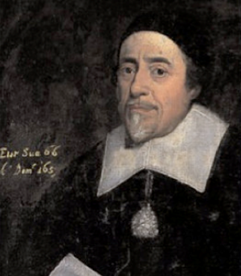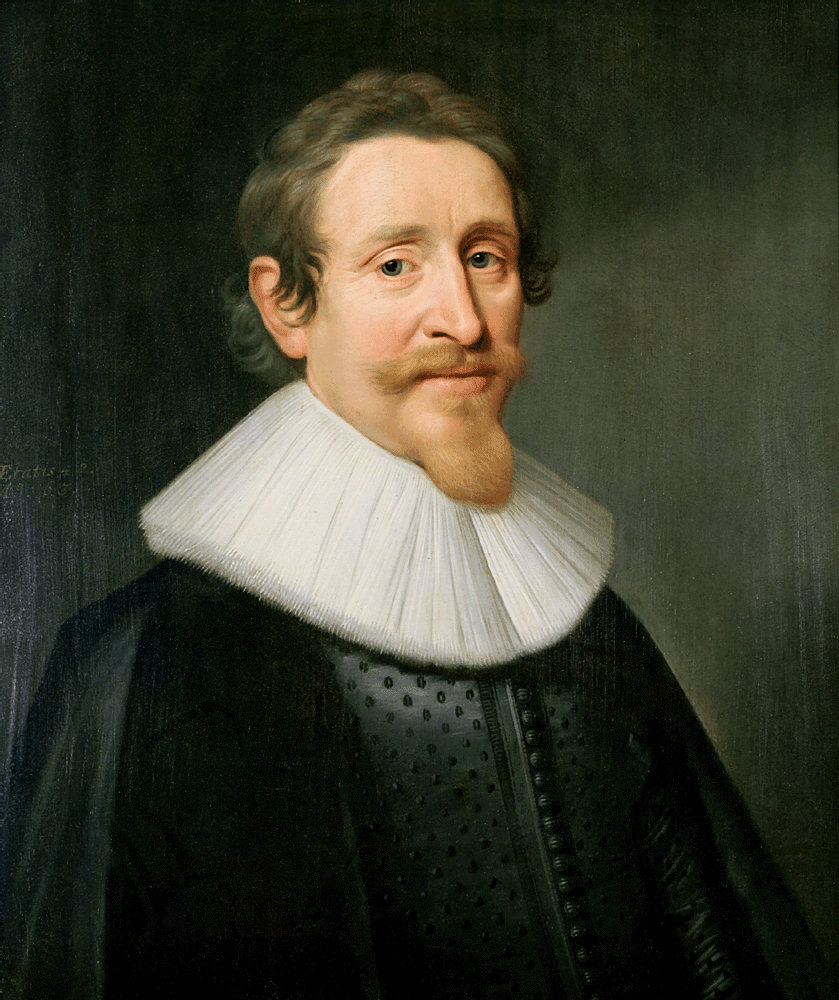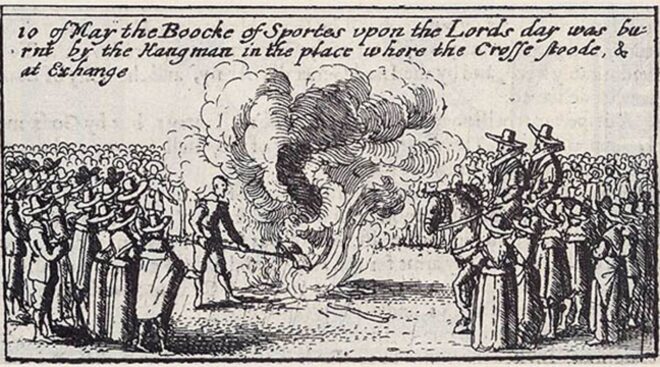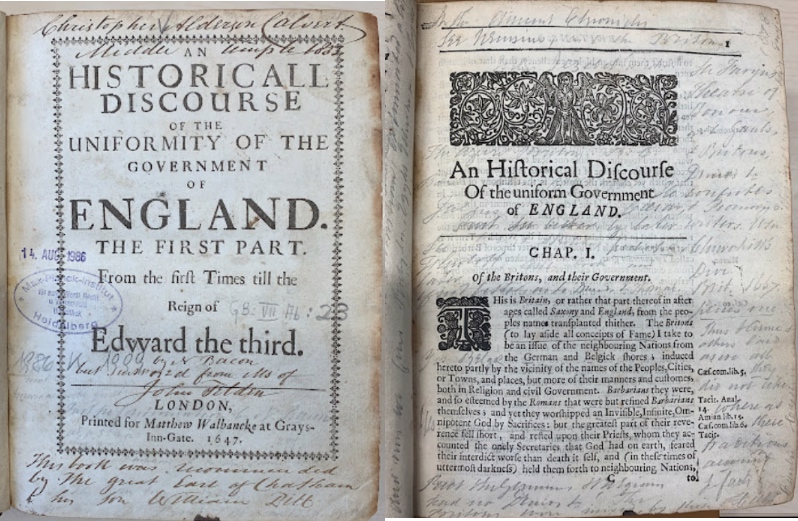In the hallowed halls of the Max Planck Institute for Comparative Public Law and International Law (MPIL) rests a treasure, a copy of Nathaniel Bacon’s An Historicall Discourse of the Uniformity of the Government of England. The First Part. From the first Times till the Reign of Edward the third. The Continuation of an Historicall Discourse of the Government of England, until the end of the Reign of Queen Elizabeth. With a Preface, being a Vindication of the ancient way of Parliaments in England. This rare find, dating back to 1672, has not only withstood the test of time but has also borne witness to the tumultuous history that surrounded its publication. Nathaniel Bacon, a presbyterian Member of Parliament for Cambridge University during the Long Parliament, penned this historic discourse during a period of intense political strife. Published in two parts, the first covering the early times till the reign of Edward III and the second continuing until the end of Queen Elizabeth’s reign, Bacon’s work stands as a testament to the challenges faced by dissenting voices during this period.
Bacon’s Bold Escape: Navigating Censorship, Prosecutions, and Secret Reprintings in the Battle for Enduring Ideas

Nathaniel Bacon (1593 – 1660)[1]
Bacon’s name is only attributed to the second part, suggesting a strategic move to avoid punishment. In a climate of strong censorship, this was a prudent tactic to protect the book from being seized and burnt. Joseph A. Dane’s insights into the bibliographical history shed light on the deliberate steps taken to safeguard this radical text. The copies of Bacon’s work faced numerous challenges, with attempts by Charles II’s government to suppress it leading to prosecutions of printers like John Starkey: in 1672, a privately reprinted work faced government prosecution upon discovery, leading to the vigorous persecution of both the publisher and the book. The government’s actions resulted in the confiscation and burning of numerous copies. The scarcity of this edition is emphasized in a passage by bookseller Starkey in the preface to the 1689 folio edition. However, despite such efforts of censorship, the work resurfaced through secret reprintings and editions during crucial periods such as the exclusion crisis and the revolution of 1689. Its endurance into the eighteenth century speaks to the enduring impact of Bacon’s ideas.
Bridging Centuries: Unravelling Mysteries Through Annotated Pages – The Enigmatic Legacy of Christopher Alderson Calvert’s Copy of Bacon’s Work
The Institute’s copy, acquired by the MPIL on August 14, 1986, holds a unique significance due to its rich annotations. Previously owned by Christopher Alderson Calvert (1811-1883), a figure intricately woven into Canterbury’s historical fabric, the annotations provide a fascinating window into the intellectual landscape of the nineteenth century. Calvert emerged as a prominent figure recurrently documented in the annals of Canterbury. His multifaceted contributions spanned various pivotal roles, including serving as the Canterbury Association secretary and later assuming the position of registrar of the Canterbury Supreme Court in 1860. Calvert’s annotations cover a broad spectrum, delving into contemporary events of the 19th century. However, the mystery lies in the numerous annotations that extend beyond Calvert’s lifetime, some even reaching into the 1920s. Some annotations appear in pen, although the vast majority are in pencil, at various points other annotators’ handwriting can be seen to differ from Calvert’s. This raises questions about additional readers and their contributions to the discourse surrounding Bacon’s work. As a heavily annotated copy, the MPIL’s volume offers a unique perspective on the evolving interpretations of Bacon’s text over time. The intricate layers of commentary, spanning centuries, enhance the book’s historical richness and contribute to the ongoing dialogue on constitutional history, radical republicanism, and the ‘Whig Interpretation of History’. As we delve into its pages, we are reminded to cross borders, trespass into historical narratives, and go beyond the confines of traditional interpretations.
Unveiling Legal History: Charting Paths for Legal Thought and Practice with the Heisenberg Project
In a manner akin to how Bacon’s treatises serve as a portal to the constitutional and political discourses prevalent in early modern England, Hugo Grotius’ foundational work and landmark seminal On the Rights of War and Peace (De iure belli ac pacis, IBP) established the bedrock for contemporary international law. The Heisenberg Project, titled “The Unseen History of International Law: A Census Bibliography of Hugo Grotius’s De iure belli ac pacis” aims to illuminate a previously unexplored facet of international law’s history through a comprehensive examination of all surviving copies of the first ten editions of Hugo Grotius’ IBP, with the goal of publishing a detailed census bibliography by 2025. This date marks the 400th anniversary of IBP’s inaugural publication, a work that has been foundational to the development of modern international law since its first edition in 1625. By systemizing the annotations made by statesmen, diplomats, and scholars over four centuries, the project seeks to uncover the rich tapestry of engagements with IBP. This endeavour not only promises to shed light on the text’s profound influence and reception but also aims to redefine our understanding of international law’s historical evolution by tracing the dissemination, interpretation, and adaptation of IBP across different epochs and geographies.
The integration of legal scholars’ findings such as those of the Heisenberg Project not only augments our comprehension of Bacon’s contributions, but also embeds them within the broader tapestry of legal historiography. This interplay between continuity and transformation in legal scholarship, and its influence on the development of legal and political institutions, underscores the pivotal role of historical legal documents in both deciphering historical contexts and addressing current legal quandaries and discussions.
Guardians of Legal Heritage: The MPIL Library Separata’s Enduring Role in Preserving and Propelling Legal Scholarship

The MPIL’s rare books collection before 2010[2]
The pivotal role of historical legal documents has long stood at the forefront of legal scholarship at the MPIL, not only through its pioneering research initiatives but also by virtue of its remarkable library. This library, with its extensive collection of over 725,000 volumes, including approximately 1000 precious works printed before the 19th century (stored separately as “Separata”) embodies the Institute’s dedication to the comprehensive study of legal history and its nuances. The acquisition and preservation of antiquarian books, such as the annotated copy of Nathaniel Bacon’s An Historicall Discourse and the foundational texts by Hugo Grotius such as IBP, allow scholars to study and understand the evolution of legal thought from its early modern roots to its contemporary manifestations. The integration of these historical texts into the MPIL’s library collection, particularly those acquired as early as 1926, underscores the Institute’s role in safeguarding the intellectual heritage of legal scholarship. This endeavour is not merely archival but serves as a vital conduit for contemporary legal research and discourse. The presence of works annotated by figures such as Christopher Alderson Calvert, and the continuity in the purchase of antique books evidenced by the library’s evolving stamps, from its early days in Berlin to its current home in Heidelberg, highlight the dynamic interplay between past and present legal thought. The library’s efforts to maintain a collection that spans the breadth of legal history, including the acquisition of early modern books during periods of heightened scholarly interest, reflect an acknowledgment of the profound impact these works have on contemporary legal theory and practice. The MPIL’s library, with its blend of historical and modern legal texts, thus stands as a testament to the enduring relevance of historical legal scholarship and its influence on the ongoing evolution of legal thought and jurisprudence. This expanded focus not only enriches our appreciation of Bacon’s An Historicall Discourse but also situates it within a living tradition of legal scholarship that continues to inform and shape the discourse on constitutional history, radical republicanism, and the interpretation of legal history.
[1] Image: public domain.
[2] Photo: Miriam Aziz.

The Grotius Research Group examines all surviving copies of the first ten editions of Hugo Grotius’s seminal “On the Rights of War and Peace” (De iure belli ac pacis). Members of the group and authors of this text are Mark Somos, Matthew Cleary, Pablo Dufour, Edward Jones Corredera and Emmanuele Salerno.


